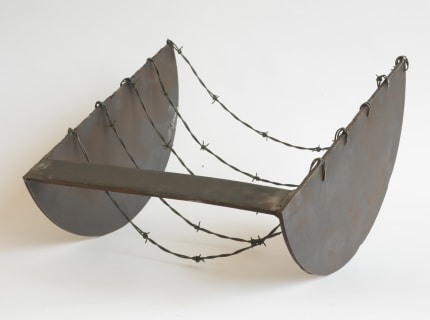“A change is gonna come,” the soul singer Sam Cooke promised in his 1964 hit song. And so it did. Officially, it arrived fast, with the signing into law of the Civil Rights Act that year. In reality, its progress was killingly slow, and by then already a decade old.
Today, half a century on, Cooke’s promise is far from being a done deal. But if you happen to have heard the song when it was new, you can still feel the bittersweet ache of faith it evoked in a harsh but acutely utopian time.
The same ache runs, from beginning to end, through “Witness: Art and Civil Rights in the Sixties” at the Brooklyn Museum, a vivid record of that time as seen through some of its art. Imaginatively chosen, the show lays to rest the idea that photography was the only memorable visual work the era produced. It plays an important part, but only a part: Most of what’s here is painting, sculpture and collage. Nor, as might be assumed, is this an exclusively black show. The roster is racially and ethnically mixed, the artists varied in degrees of familiarity. Some, like Jacob Lawrence, Frank Stella and Norman Rockwell, are well known, though not necessarily in this historical context. Others — Cleveland Bellow, LeRoy Clarke, Virginia Jaramillo, John T. Riddle Jr. — are rare visitors to our major museums.
The show gets the balance of history right in other ways, too, by letting it be confused and confusing, a thing of loose strands and hard questions.
Are Andy Warhol’s 1964 “ Birmingham Race Riot” silk screens, with their news photos of police dogs attacking protesters, opportunistic or empathetic? Can we look at a 1970 Gordon Parks photograph of the radical young Eldridge Cleaver without thinking of the aging conservative he would become?
Can we stop thinking about the civil rights era, or any era, as a saga of a few lionized male leaders, and conceive of it instead as the story of thousands of everyday people going about their unsensational lives until, when necessity calls, they show up, line up, shout out and do without, individually and together, for the good of all, even for a good that they are aware they may never personally experience?
As organized by Teresa A. Carbone, curator of American art at the Brooklyn Museum, and Kellie Jones, associate professor of art history at Columbia University, such questions are built into the show right from the start.
...
Even in the section of the show called “American Nightmare,” which is almost entirely about violence, a balance between document and metaphor holds. Charles Moore’s famous 1963 photos of Birmingham demonstrators under police assault are here. But so is Jack Whitten’s response to that incident: an all-black painting punctured by a gaping hole, like a peeled-open wound, with a photo embedded, barely visible, deep inside.
The most moving statement of the theme, though, comes in three large paintings that form a chapel-like enclosure. On the right is a 1969 Philip Guston image of cartoonish Klansmen, on the left a smoldering Norman W. Lewis painting of what looks like a field of burning crosses; and in the middle Sam Gilliam’s magnificent 1970 “Red April,” a wide pale curtain spattered with blood-red paint and inspired by the 1968 murder of the Rev. Dr. Martin Luther King Jr.
...
Read full review at nytimes.com.



